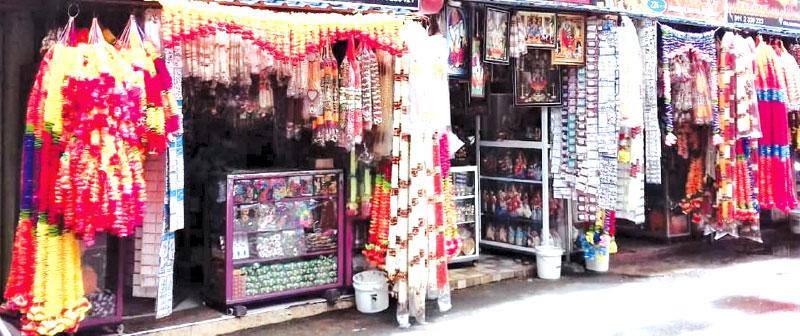
Flowers have been used in sacred worship for centuries, by all religions. They are piously offered to deity. With modern conveniences overtaking our lifestyle, flowers and garlands seem to be going out of vogue. However, one area in the Pettah sustains this beautiful tradition associated with flowers. As you walk along Kathiresan Street and take a turn to your right you will come across Andival Street.
 At the end of this road Sea Street rises to dominate the area with its gold jewellery shops. Nearing the topmost end of this road is the Kathiresan Kovil, with its grey “gopuram’ (tower) standing like a solitary sentinel.
At the end of this road Sea Street rises to dominate the area with its gold jewellery shops. Nearing the topmost end of this road is the Kathiresan Kovil, with its grey “gopuram’ (tower) standing like a solitary sentinel.
Along this area I was able to witness the skills of men, patiently making garlands with fresh flowers. For more than fifty years this area has been the domain of garlands, used for every religious and social event of the Tamil speaking community - which includes Hindus and Christians.
Vairawanathan was seated on a wooden stool, his eyes gazing on the thread that binds the garland. He looked up and quoted his prices. We began to talk, and he said “ I have been here for 38 years, making garlands which devotees take to worship at this kovil and other kovils around the area.
Today, we still manage to get our fresh flowers, but it is not easy.” He pointed at the wild jasmine flowers which are the common choice, and takes five minutes to weave and are sold at Rs150 each.
Vairawanathan explained “Each garland has a purpose in terms of worship, and is affiliated with various Hindu festivals. See this green Thulasi leaves, the garlands made of this are offered to Vishnu. The best quality Thulasi comes from as far as Anuradhapura.
At times, we are very busy, when we have prior orders for wedding garlands, the minimum price of which is Rs 500 and varies as per the customer’s choice. Over the past 3 years the trend of some customers has shifted to artificial flower garlands”. Vairawanathan, a resident of Hatton, has spent many years making garlands, the intense focus of which has resulted in a mild squint on his left eye.
Adjacent to this garland stall is another young man, probably in his early twenties. Vishvanath had just finished making three large garlands which are suspended on a hook. The garlands seem to match his height. He explained, “These jasmine garlands are used to decorate kovils and also the manawara - the pedestal where Hindu couples get married.
It takes a longer time to make these jasmine streamers”. Vishvanath wears a Cross on his chain though a Hindu. I walked back passing the kovil entrance, where a pooja is in progress. On the other side a bearded man is busy at work. He is Muthukumaran, the senior most garland maker who has been in business for 50 years! His finger nails are stained from the natural dyes of the flowers. He greeted me and said “I came from Kandy when I was just eight years old.
Colombo was a very different city those days. I learnt my craft here, and have no regrets. I feel I am helping people in their act of sacred worship. On Fridays we are very busy. Many devotees come to the kovil”. The amiable old man continues to make a garland as he talks. He pointed to a bunch of thin needle like grass and explained, “You may not have seen this? Brother, this is known as arugampullu, and is used for specific forms of worship. The best quality comes from the Puttalam area. Some now buy artificial garlands, but we feel, fresh garlands have a special aura. The devotees have a choice”
Walking via Andival Street, we approach a line of six shops selling artificial garlands, bursting in beautiful colours. The vendors began to offer discounts. One salesman declared “These garlands are from India. As you know there many kovils there of great prominence. We don’t compete with the natural garland makers, but we offer the devotees a choice”.
These shops sell the famous urutharasai mallai - a chain made with wooden beads, often used by meditating sages and pious hermits in India. Thus, a mix of natural and artificial garlands adorns this area down Sea Street. But the garland making skill is a dying craft. Perhaps, in his poem ‘Hematreya’, the prudent poet Ralph Emerson has a deeper point when he makes mention of the earth laughing with flowers and wisely concludes with the lines “When I heard the earth song, I was no longer brave. My avarice cooled, like lust in the chill of the grave”.
